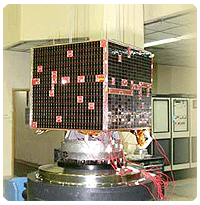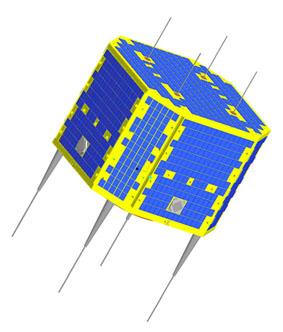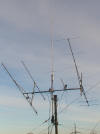I am operating via amateur radio satellites OSCAR,
(OSCAR means abbreviation from
Orbiting Satellite Carrying
Amateur Radio)
such as AO-7,
AO-10, AO-13, AO-27, FO-20, FO-29,
SO-50, UO-14, AO-51, VO-52.
Some
of themes are not operable any more (AO-10, FO-20, UO-14 due the
battery problems.
AO-13 was
crashed in December 1996.)
I was also active via AO-40, modes U/S2 and L1/S2, before he was die
in January, 2004...
Uplink U-band
(435.550 - 435.800 MHz): FT-847 antenna 4 x 19 el. yagi with
horizontal polarization,
usual array,
which I using for 432 MHz CW/SSB
DX-ing. Not the best for satellite communication,
because of
high SWR
on 435,5 MHz and
linear polarization!
Uplink
L1-band (1269 MHz): FT-736R + 55 elements F9FT, 10 watt output.
Downlink
S2-band (2401.225 - 2401.475 MHz). Down converter, type MKU 24 TM
OSCAR (from DB6NT),
which I
installed on the dish antenna (67 cm in diameter) with LHCP patch,
designed by 7N1VNW and
optimized
by
K3TZ.
Very easy! It Has been made in
a few hours! This dish was
installed on the H-frame
between of
4x19 el. yagis and
worked good enough without any additional adjustment!
Look at the
pictures.


My QSOs on the first day (28.02.2003) on AO40 were:
VK1VL, JA1CG,
JA0BBW, ZS6JON, ZS6JT, EX8MLT
and many others from
Europe.
Another antenna has been tried for AO-40 downlink - 21 turns helix
together with my new
down
converter
(2401/145 MHz) from
Parabolic AB (Sweden).
But
I was
not lucky of this antenna - read this article.


Unfortunately, the AO-40 is dead in January 2004 and nobody knows, if
it will return back
to the life...
Just
let's hope and keep our converters
in a
safety place!
Here is
online AO-40 Activity Report Logger by
HB9DRI.
Some
comments are there....
The latest news regarding to the AO-40 is possible to get from
AMSAT-DL
Amateur satellite AO-51(AMSAT ECHO)!
 OSCAR E
("Echo") - is a microsat-class satellite under construction by
OSCAR E
("Echo") - is a microsat-class satellite under construction by
AMSAT-NA. Similar
to original Microsats AO-16, DO-17, WO-18, LO-19 and
descendents IO-26,
AO-27,
MO-30, SO-41
AO-51 was launched on June 29, 2004 from the Baikonur Cosmodrome.
After about 1 month of tests it was open for HAMs operation...
Echo carries a
FM repeater capable of 144MHz and/or 1.2GHz uplink with a 435MHz
and/or
2.4GHz downlink. Also, it has AX.25 digital PACSAT BBS and a PSK31
uplink
on 28MHz.
The satellite is available for worldwide usage for voice and data
communications.
PL tone 67Hz must be used on uplink frequency.
Very
good running and
there
are my firsts QSOs via AO-51.
The main and most official information about AO-51 (such as operation
schedule, modes and control
team
news) is
possible to get from
AMSAT-NA
site.
The micro satellite VO-52 (HAMSAT)
 Was
blasted off from the Satish Dhawan Space Centre in Sriharikota on
Was
blasted off from the Satish Dhawan Space Centre in Sriharikota on
Thursday,
05.05.2005, at 10.22 hrs IST. HAMSAT was inserted to a Near
Circular
Sun
Synchronous Polar Orbit (628 kms) at 10.41 hrs IST.
Telemetry received from the HAMSAT says all systems are healthy.
Salience features
Dimensions:
630mm x 630mm x 550mm Cuboid
Mass: 42 Kgs
Antennas: UHF Turnstile, VHF Turnstile
Orbit: Near Circular Polar Low Earth Orbit
Structure: Aluminium Honey Comb Structure
HAMSAT
frequencies, Mode B (UV):
|
Indian transponder:
Uplink : 435.225MHz to 435.275MHz LSB/CW
Downlink: 145.875MHz to 145.925MHz USB/CW
Beacom : 145.940MHz continue carier signal
|
Dutch transponder:
Uplink : 435.225MHz to 435.275MHz LSB/CW
Downlink: 145.875MHz to 145.925MHz USB/CW
Beacon : 145.860MHz 12WPM with CW message |
Here is extraction from my
log book (VQLog) of the several first QSOs via HamSat.
Micro satellite DO-64 (Delfi - C3)
On the 28th of April at 03:53 UTC the Delfi-C3 was succesfully
launched with a PSLV launch vehicle. At 06:45 UTC the first signal was
recieved from a radio amateur in California. At 11:55 UTC the
satellite signal was acquired and decoded at the TU Delft
groundstation, initial analysis showed the craft to be in excellent
condition, all solar panels and antennas were deployed and the
internal temperatures and voltages were within the ranges expected.
The most recent micro satellite "XW-1" (Also "Hope OSCAR 68" or HO-68)
Launch Date: December 15, 2009

Apogee: 1200km
Perigee: 1200km
Inclination: 105
Period: 109
Dimension: Φ680mm×432mm
Mode V/U (J) FM Voice Repeater (30 dbm (1 w)):
Uplink: 145.8250 MHz FM, PL 67.0 Hz.
Downlink: 435.6750 MHz FM
Mode V/U (J) Linear Transponder (Inverting) (30 dbm (1
w)):
Uplink:145.9250 - 145.9750 MHz SSB/CW
Downlink:435.7650 - 435.7150 MHz SSB/CW
Mode V/U (J) PacSat BBS (30 dbm (1 w)):
Uplink:145.8250 MHz AFSK 1200 BPS
Downlink: 435.6750 MHz AFSK 1200 BPS
Mode Beacon (23 dbm (200mw)):
Downlink:435.7900 MHz CW
My antennas for satellite
operation
This
antennas setup I did used for experiments with satellites (mainly AO-51,
because nothing to do with
a nother
satellites!) in KO29IJ (Tallinn). Full elevation, computer controlling
via KCT-board.
nother
satellites!) in KO29IJ (Tallinn). Full elevation, computer controlling
via KCT-board.
Antennas for 23 cm, 70 cm and 2 m bands has mast preamplifiers.
From the
left to the right:
- 19 elements yagi for 70 cm band (Värgarda
AB);
- 35 elements yagi for 23 cm band;
- X-400 dual band 145/435 MHz vertical (Diamond);
- 21 turns helix with down converter (2401/145 MHz) for "S"-band
(Parabolic AB, Sweden);
- 9 elements yagi for 2 m band (Värgarda
AB). This setup not exist any more.



